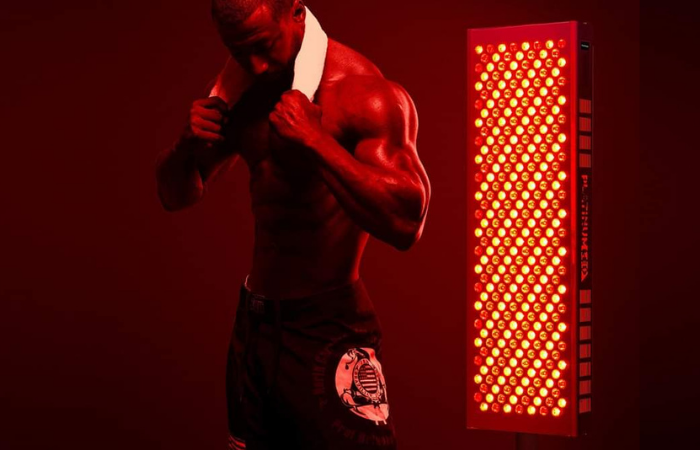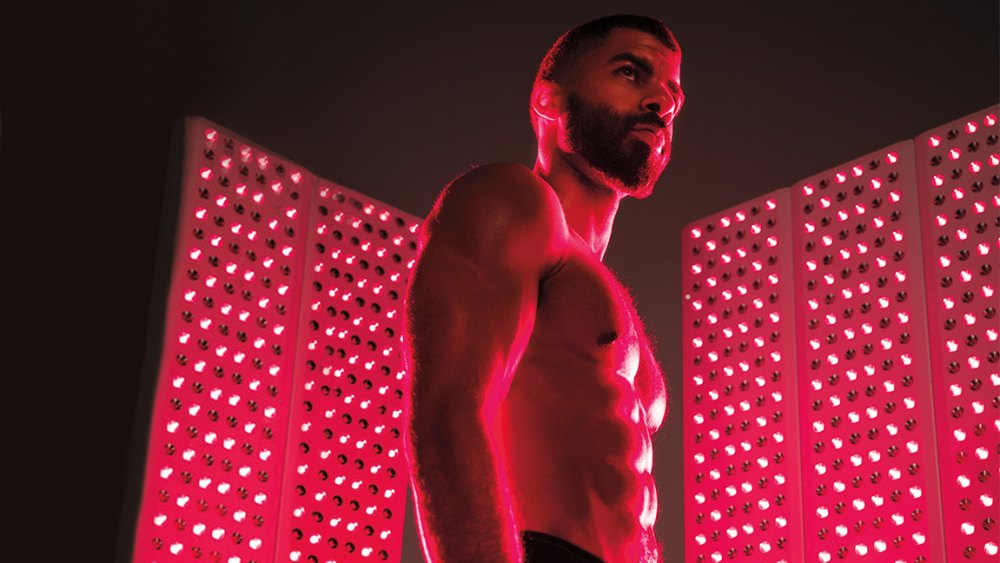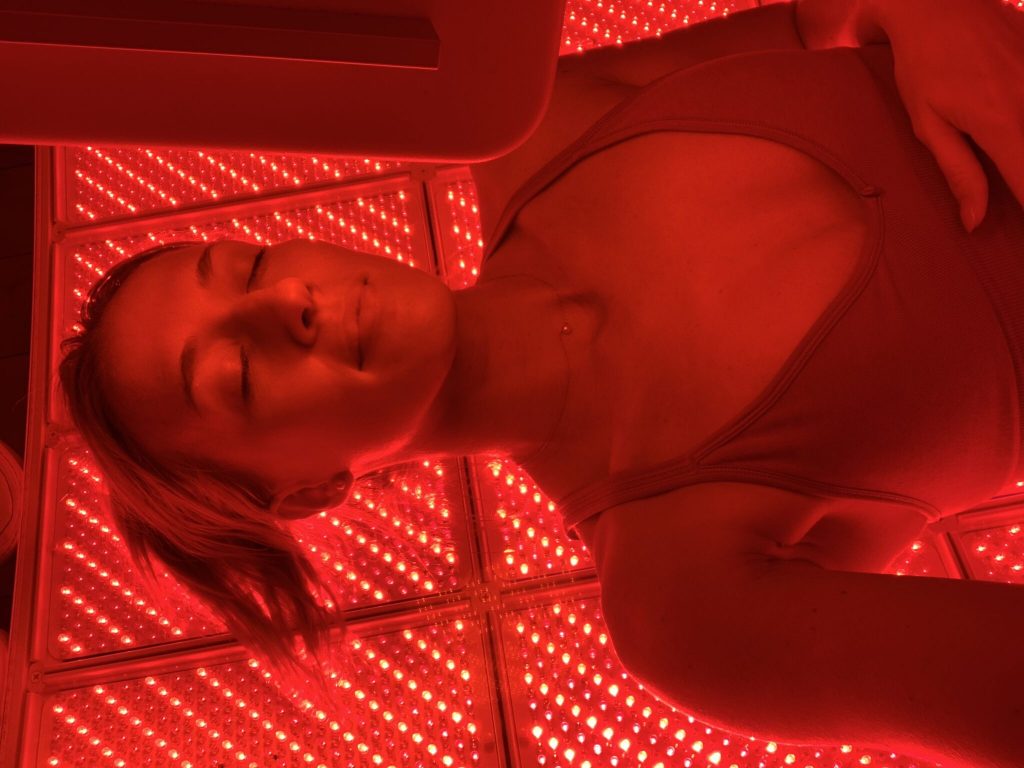RED & INFRARED LIGHT THERAPY
HAVE YOU TRIED RED & INFRARED LIGHT THERAPY
- IMPROVE SKIN TONE AND COMPLEXION, REDUCED ACNE, OSACEA AND ECZEMA.
- IMPROVED APPEARANCE OF WRINKLES, FINE LINE AND STRETCH MARKS.
- INCREASED ATHLETIC PERFORMANCE MUSCLE & TESTOSTERONE.
- $30 FOR A 20 MINUTES SESSION
HOW DOES RED & INFRARED LIGHT THERAPY WORKS
- OUR NEURONS NEEDS ENERGY TO FIRE
- OUR MUSCLES NEEDS ENERGY TO CONTRACT
- OUR IMMUNE SYSTEM NEEDS ENERGY TO FIGHTS DISEASES.
- TO PRODUCE ENERGY OUR CELLS USE THE MITOCHONDRIA
- ACHIEVE HOMEOSTASIS
- RED AND INFRARED LIGHTS THE GOOD RAYS OF THE SUN LIGHTS FOR OUR ENERGY
DOES RED & INFRARED LIGHT THERAPY REALLY WORKS?
- MORE THAN 15 YEARS OF SCIENTIFIC RESEARCH BASED ON MORE THAN 10.000 YEARS OF UTILIZATION
- ENERGY CANNOT BE CREATED NOR DESTROYED BUT CAN ONLY CHANGE ITS FORM
- RED & INFRARED PENETRATE ALL THE WAY THRU ALL LAYERS OF OUR SKIN REACHING OUT TO OUR ORGANS AND BONES
RESEARCHED BACKED BENEFITS OF RED & INFRARED LIGHT THERAPY
- FASTER AND BETTER HEALING
- YOUNGER AND HEALTHIER SKIN
- DECREASED PAIN
- INCREASED NITRIC OXIDE
- BETTER BRAIN HEALTH
- IMPROVED RECOVERY AND ATHLETIC PERFORMANCE


























WHAT IS LIGHT THERAPY ?
Light therapy—also known as photobiomodulation (PBM)—is a natural, non-invasive therapy that delivers beneficial wavelengths of light to your skin and cells. Full-spectrum light includes many colors, including wavelengths we can’t see, but only a select range of red and near-infrared light is clinically therapeutic for the purposes of PBM.
A legit light therapy device uses medical-grade LEDs to deliver clinical doses of light power to your skin, without heat, excess UV rays, drugs, chemicals, or major side effects. Red light therapy has been used in fancy spas and clinics around the world for a few decades, but only in recent years can you buy a device for your own home, and that’s been a huge game changer.
A light therapy device harnesses therapeutic wavelengths of natural light and delivers it directly to your skin. The photons of red and near-infrared react with the mitochondria in your cells, where they stimulate the electrons during cellular respiration—the process that’s responsible for all our adenosine triphosphate (ATP) production.
Here’s a bit more detail on the mechanisms at play: red and near-infrared light has a particular resonance with a key enzyme during cellular respiration—cytochrome c oxidase—or CCO for short. When our bodies are stressed or overworked, we produce a lot of nitric oxide (NO).
It’s a cool little molecule, but just like anything, too much can be a bad thing.
During cellular respiration, excess NO tends to bind with CCO, which can halt the production of ADP—adenosine diphosphate—a precursor to ATP. This is where red and NIR light comes into play. These wavelengths can sort of “excite” the electrons during oxidative phosphorylation—the last phase of cellular respiration. This, in turn, breaks the bonds between NO and CCO, resulting in normal cellular function and the eventual production of more ATP energy. Because NO is freed up at the same time, it’s also one of the reasons most people—including yours truly—feel a pump after using light therapy.
There are some secondary mechanisms at play too. Natural red and NIR light can help create a better oxidative environment in your cells, resulting in the activation of numerous intracellular signaling pathways, increased protein synthesis, enzyme activation, and enhanced cell cycle progression.
One more thought on how light therapy works: the aforementioned mechanisms are pretty well-accepted by researchers studying PBM. However, there’s still a lot we’re learning about the therapy. For example, some smart folks from Sydney University in Australia recently discovered that red and NIR light can help restore healthy gut microbiome, which suggests a different mechanism of action altogether.
At the end of the day, it’s pretty obvious that certain wavelengths of light are highly beneficial, which I’ll cover in more detail below. But it still feels like we’re on the edge of truly understanding how this all works in our bodies.
CLINICALLY - PROVEN HEALTH BENEFITS?
One great thing about light therapy is that it’s been widely studied in clinical trials around the world for decades, starting with NASA nearly 30 years ago. In trial after trial, light therapy has been found safe and effective at promoting a wide range of pretty incredible health benefits. Now let's geek out on some of the science.
These are some of the major areas that are backed by a large body of clinical research
Skin Health & Anti-Aging: Studies have found light therapy improves skin tone & complexion, diminishes signs of aging, speeds the healing of wounds and scars, and boosts natural collagen production. In one double-blind, placebo-controlled study, 74% of the participants reported a visible improvement in fine lines and wrinkles. Natural red and near-infrared light has also been found in clinical trials to have a therapeutic effect on the symptoms of painful skin conditions like psoriasis, herpes, and acne.
Muscle Recovery & Physical Performance: This one is my wheelhouse and the biggest reason I swear by my daily, full-body red light therapy sessions. When you train hard and perform at a high physical level, muscle recovery is essential. Red light helps my body spring back from the pain and strain of a punishing workout faster, so I can do it all over again sooner without getting hurt. Being able to train more and stay healthy is the best natural formula for gaining a competitive advantage, regardless of what sport you play. Red light not only helps you recover, but it stimulates muscle growth too. One study—from the European Journal of Applied Physiology—compared muscle growth and strength between two groups of athletes—one using light therapy combined with exercise, the other using exercise alone. Researchers demonstrated that muscle thickness and strength were significantly improved (by over 50%!) in those who used light therapy. These results were clearly measurable using ultrasound imaging and isokinetic dynamometry.
Joint Pain & Inflammation: In 2000, a systematic review in The Journal of Rheumatology set out to see just how effective light therapy could be for arthritis. This review found significant results across thirteen randomized controlled trials. The best results were demonstrated in people suffering from rheumatoid arthritis, with light therapy reducing participants’ pain by 70 percent compared to the placebo.
Increased Cognitive Function: One clinical study of men and women with a history of traumatic brain injury were administered red and NIR light therapy treatment for their brains in 18 sessions over 6 weeks. The researchers noted improved sleep, better executive functions, improved social functioning, and an increased ability to perform tasks and activities. Participants also reported improvements in depression, anxiety, headaches, and overall cognition.
Healing Wounds & Burns: Red light therapy has been shown in trials to aid the healing of wounds, burns, and scars by inducing the release of cytokines and chemokines in cells. In a 2018 study of light therapy and chronic wounds in diabetes patients, researchers found that the group treated with an LED device for 8 weeks resulted in scars with a smaller mean surface area compared to the non-LED group.
Melatonin & Sleep: I’ve mentioned many times how I’ve been sleeping better since strategically incorporating light therapy into my daily routine. Artificial light can knock your circadian rhythm out of whack, but red and near-infrared light does the opposite and helps reset your internal clock. Clinical studies show light therapy also increases natural melatonin production for healthier sleep.
THESE ARE SOME OF THE MOST COMMON HEALTH BENEFITS YOU CAN SEE FROM CONSISTENT DAILY RED LIGHT THERAPY:
Muscle recovery & physical performance: Bottom line, red light therapy helps me work out harder and faster, with less pain. Red light gets your cells making energy on high octane so you can perform at your peak. It also boosts your muscle gains by stimulating growth.
Skin health: Red light was originally popular as a skin treatment in fancy spas and salons. Red light is great for your skin for the same reason it’s great for muscles: it boosts ATP energy production in the cells and helps clear out the body’s inflammation. Studies have found light therapy improves skin tone & complexion, diminishes signs of aging, and even can boost your collagen production.
Better blood flow: Standing in the glow of red light really gets the blood pumping, literally. When your cells take in all those photons of red and NIR light, your tissues are able to use more oxygen and improve the efficiency of your circulation.
Managing inflammation: One of the primary benefits of red light therapy treatments is a proven anti-inflammatory effect.
Inflammation is natural and necessary, but you have to process it and deal with it or it can become chronic and painful. When I’m sore or tired, red light therapy sessions help me control the inflammation and start the healing process efficiently.
THE LATEST RED LIGHT THERAPY RESEARCH
Light therapy has been studied and used to improve human health for over a century.
Way back in 1903, a Danish physician named Niels Ryberg Finsen won the Nobel Prize for pioneering some of the first clinical light therapy treatments.
Finsen used red light to treat smallpox and other light spectrums to address chronic diseases such as tuberculosis. In the decades following, Finsen phototherapy became more developed as a cutting-edge therapeutic intervention in modern medicine.
More recently, in the 1980s, NASA studied red light therapy use in space for health and plant growth. Since then, NASA has continued to work with a Wisconsin-based company called Quantum Devices Inc., the developer of a far-red/near-infrared light-emitting diode treatment called High Emissivity Aluminiferous Luminescent Substrate (HEALS). The HEALS device has proven therapeutic for painful cancer treatment side effects and even the reduction and potential elimination of cancerous tumors.
The positive outcomes of treatment with the HEALS led Quantum to design a new, non-invasive medical device called the WARP 10 (Warfighter Accelerated Recovery by Photobiomodulation). The WARP 10—a high-intensity, hand-held, portable LED unit—works for the temporary relief of minor muscle and joint pain, arthritis, stiffness, and muscle spasms, while also increasing local blood circulation. The evolution of light therapy at NASA is indicative of the broader movement from red light therapy as a specialized, relatively inaccessible tool to a home healing mechanism. As device technology improves by leaps and bounds, the scientific research on light and red light therapy has really taken off.
More than 1,000 peer-reviewed studies have been published on red light therapy treatments in the last two decades alone. The biggest consensus across these trials and studies is that red light therapy treatments are safe and well-tolerated by patients, with very few side effects. Some of the most common findings across studies are how red light treatments can increase cellular energy output and reduce a person’s inflammation response, which has shown a large range of benefits for skin, sleep, fitness, recovery, and more. Newer, emerging research is also pushing the boundaries of what red light treatments can do. Below, I’ll talk more about three fields of red light therapy in which the research is developing rapidly.
NEWLY RESEARCHED BENEFIT #1: RED LIGHT THERAPY AND HORMONAL HEALTH
As I’ve said before, red light therapy is showing a great deal of potential for hormone health.
The thing is, your natural hormone levels start to dip as you get older.
This happens for both men with testosterone and women with waning progesterone and estradiol levels. Even if you stay in excellent shape, those levels dip over time. Every organ in your body, including the adrenal glands, age over time and become less efficient at producing hormones.
So how does shining light on your body help women boost progesterone and men improve their testosterone levels? The short version is that wavelengths of red and NIR light appear to support the mitochondria in the adrenal glands, which are responsible for generating cortisol and adrenaline. They also synthesize dehydroepiandrosterone (DHEA) an endogenous hormone precursor that plays a major role in the production of sex hormones like progesterone, estrogen, and testosterone. DHEA levels diminish with age in both men and women, which results in lower levels of progesterone and testosterone.
In 2019 and 2020, the company that makes the red light therapy devices that I use and recommend, Joovv, partnered with a functional medicine practitioner in Minnesota to conduct a novel hormone health study on the impact of light therapy and a ketogenic diet. In the study, male and female patients tried a 12-week light therapy program using a Joovv Elite (the device I use daily) once per week along with daily in-home sessions with the Joovv Solo. The patients were separated into two groups: people who ate a strict keto diet while using red light therapy and patients who kept a standard diet. This is really the first study to look at how light therapy and diet interact to affect hormone health—and the results were eye-opening.
Women in both groups saw their progesterone levels increase significantly, with the keto group seeing the biggest gains. Pre-menopausal women in both groups also saw significant increases in estradiol levels after light therapy treatments. I’m talking upwards of a 78% increase for younger women, which is pretty incredible. These results suggest light treatments help increase women’s endogenous production of DHEA and progesterone, which could be a game-changer for women who struggle with hormone imbalances.
As for the men in the study, they all saw significant gains in testosterone levels across the board. A few men over 40 actually saw an increase of over 100% in their total testosterone levels. Granted, the participant size was small, but nonetheless, the results confirm that there is solid potential for red light therapy to be a primary treatment tool for hormonal imbalances.
NEWLY RESEARCHED BENEFIT #2: RED LIGHT THERAPY AND THE GUT MICROBIOME
Another emerging arena of red light therapy research is how it might improve conditions in the gut microbiome.
Every year, we’re learning more and more about how crucial gut health is for overall health and longevity.
I’ve been keeping up with recent laboratory research that’s showing how red light therapy can have a potentially significant effect on the gut microbiome. Researchers have demonstrated that red light therapy treatments can alter gut health and help control the body’s production of harmful cytokines during the natural inflammatory processes. That alone can have a huge impact on limiting chronic diseases, from cardiovascular issues to other autoimmune and metabolic problems. (Note that cytokines—which are any of a number of substances secreted by certain cells of the immune system that have an effect on other cells—can be both “good” and “bad.”)
Why does shining light on your body affect the gut microbiome? Researchers believe a potential mechanism of action for light therapy treatments is the reduction of inflammation in the adipose tissue (a central metabolic organ in the regulation of whole-body energy homeostasis) of the abdomen. The anti-inflammatory benefits of red light therapy are already well-established. Research has also shown that light therapy treatments can protect against cytokine “storms”—when an overload of cytokines is released into the body—associated with inflammatory diseases.
NEWLY RESEARCHED BENFIT #3: RED LIGHT AND INFRARED & COGNITIVE HEALTH
The human brain is deeply affected by light intake, particularly in regards to your sleep and circadian rhythms.
Now, new research is also showing how shining red light on your head and brain cells may also improve your cognitive functions like memory and executive function.
A brand-new study published in 2021 shows evidence that the brain can process difficult cognitive tasks more effectively after light therapy exposure. In this recent trial, 33 adults were divided into control and experimental groups, with the experimental group receiving light treatments. The control group did a similar sham treatment (the same procedure but without machine activation). Both groups performed rigorous cognitive tests before and after the treatments to test their working memory and their hemodynamic responses to the work.
The results were extremely encouraging: only the experimental (light therapy) group saw a significant drop in frontal hemodynamic measurements during difficult cognitive tasks. What that means is that after light therapy treatments, people were able to perform difficult tests with less cognitive effort and difficulty. In short, tasks with higher memory loads may be easier to work through after your brain has received specific wavelengths of light.
This study builds on earlier work a few years ago showing how wavelengths of near-infrared light can reach the brain and brain cells and have a significant effect on cognitive abilities, inflammation, and cognitive repair. The authors of this 2016 study outlined how cranial light therapy treatments could be a promising tool to repair brain injury caused by stroke and neurodegenerative diseases.
WE ARE A REGISTERED ACC VENDOR AND WE ALSO WORK WITH WINZ – SO IF YOU HAD AN ACCIDENT OR AND INJURY – THEY COULD HELP YOU OUT TO HAVE ACCESS TO ALL OUR BIOHACKING AND LONGEVITY TREATMENTS